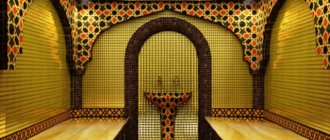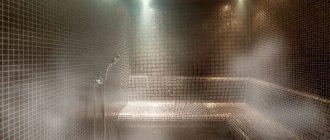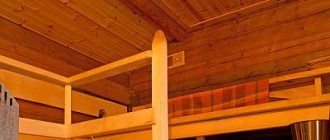If you are accustomed to the harsh steam of a classic Russian bathhouse, then your first acquaintance with a hammam will probably offend you: the temperature in a Turkish bath is not so high - up to 55 degrees. This is probably due to the peculiarities of the climate zone in which Turkey is located: the Turks, caressed by the sun's rays, want to relax in the bathhouse first of all, and not conduct a stress test to determine their body's resistance to critical temperatures. At the same time, in Russia the number of people wishing to set up a hammam in their already completed bathhouse is rapidly growing. Do you find this idea dubious? Then we are coming to you - with useful tips for installing a Turkish bath, relevant drawings, photos and other visuals that will help bring the project to life.
Features of the Turkish bath
Temperature alone cannot express the specificity of the hammam. There are plenty of other remarkable moments in the Turkish bath. About them - below.
- the steam supply is regulated by a steam generator located in a separate room;
- interior decoration - tiles or stone;
- a massage table;
- complex ventilation system;
- domed ceiling;
- high humidity in the steam room.
As you can see, this type of bath is perfect for all those who cannot tolerate high temperatures. And there is absolutely nothing complicated in the construction of a Turkish bath, but if you decide to integrate its elements into your regular bath, then it is worth considering some of the details much more thoroughly.
How to build a hammam with your own hands step by step
Preparatory work for the construction of a hammam begins with the installation of utility networks: sewerage, water supply, heating. The arrangement of the Turkish bath begins after completion of the rough work: concreting, installing a subfloor, plastering the walls.
The rough work is done, now you can start insulating and finishing the steam room
The basis
An important stage in the construction of a hammam is the insulation of all surfaces of the room. An electric cable is most often used for heating, since the water circuit requires a thicker layer of screed. Electric heating is arranged according to the principle of electric heated floors. The pie looks like this:
- ceiling or wall;
- waterproofing layer;
- heat insulator;
- heating cable fixed with mounting tape;
- reinforcing layer;
- finishing screed 30–50 mm thick.
You can also use ready-made resistive mats, the use of which greatly simplifies the calculation of heating power and its installation. On average, for uniform heating of the hammam, a power of 0.5 kW per 1 m2 is sufficient. Experts say that the heating intensity should be 2–2.5 times less than for a sauna.
To lay the heating circuit, special recesses are cut in the seats
When installing water heating of surfaces, sun loungers and seats, they are guided by the principles of installing a water heated floor. In the cold season, heating operates from a heating system, in summer - from a water boiler, electric, gas, solid or liquid fuel.
DIY steam generator
In a Turkish bath, it is recommended to maintain the temperature at 45–55°C. Humidity is created by a steam generator. This is a device equipped with an electric heating element and a container of water. The operating principle and design are in many ways similar to a conventional electric kettle.
The recommended power of a homemade steam generator is 3–5 kW. In order to reduce energy costs, it is often combined with a heater stove. In this case, additional steam generation is ensured by supplying water to the hot stones. This option is disadvantageous because it will require additional costs for the construction of a brick heater.
Factory steam generators are equipped with automation and remote control
A standard purchased steam generator consists of several elements:
- water containers;
- filter;
- steam generation unit;
- heating element;
- control panel;
- automatic shutdown sensor when water level is low.
For self-production you will need:
- metal container with thick walls (empty gas cylinder, double boiler);
- water container;
- electric heating element (TEH);
- metal tube with threads and nuts on both sides;
- rubber seals;
- steam outlet pipe;
- flexible hose or pipe for supplying steam to the hammam;
- electrical cable with plug;
- tools: set of wrenches, drill, drill bits.
Stages of work:
- The gas cylinder is washed with any detergent. Dry it. The steamer does not require preparation.
- In the lower part of the body of the future steam generator, holes are drilled through which the heating elements will be attached.
- Fix the heating element using nuts and rubber gaskets.
- A water container is installed next to the steam generator body. The two structural elements are connected with a copper tube with external threads and nuts at both ends. The design is created on the principle of communicating vessels. As the water evaporates in the steam generator, a new portion is supplied from a nearby container.
- A hole is drilled in the cover of the housing with a heating element and a hose is connected through which steam will be supplied to the hammam.
A homemade steam generator is installed in the room next to the steam room.
How to make sunbeds
The easiest to manufacture and most affordable sun lounger is made from PSB-35 and PSB-50 foam plastic. These materials are easy to process and allow you to give the product any shape, make the lines smooth and the corners rounded.
Various shapes of massage tables, seats and loungers promote correct body position for relaxation and rest.
Stages of work:
- Using a knife and a special device for cutting foam, a deck chair is formed.
- The surfaces are reinforced with glass fabric facade mesh with a density of 145 g/m2. It is glued to Ceresit CT 85 glue or a composition with similar properties. The glue layer should be such that the mesh is completely immersed in it. A recess is made in the back or seat of the lounger for installation of heating. This tunnel is also subject to reinforcement.
- Apply 2-3 layers of waterproofing mixture. Each next one - after the previous one has dried.
- The lounger is lined with natural materials or mosaic and ceramic tiles.
Sun loungers and seats in the hammam with mosaic decoration look great
This product can withstand a weight load of up to 250 kg/m2.
Loungers longer than 2 meters must be divided into three zones, each of which has its own temperature sensor.
How to make a kurna for hamam
The arrangement of the hammam involves the installation of decorative elements, one of which is the kurna. This is an elegant container from which water is drawn to wash the body and cool the sunbeds. In a traditional Turkish bath, kurnas are made without drainage. The water overflows the bowl and flows onto the floor. In modern hammams, water tanks are provided with drainage. This makes cleaning the room easier and ensures that it stays clean.
This source of water is the focal point in the interior of the hammam, all other elements emphasize it
Kurnas are made from different materials:
- marble;
- beautiful types of natural stone (mainly onyx);
- polystyrene foam
Homemade bowls made from PSB-35 are reinforced in the same way as sun loungers, and then lined with ceramic or glass mosaic. Stone and marble kurnas are heavy and require fixation with glue or sealant. It is recommended to secure foam products in a similar way, which will prevent the container from accidentally tipping over.
What needs to be done for the device
So, you have an already decorated bath room - and the availability of free square meters allows you to think about installing a Turkish bath in one of the available areas. What do we do next?
- we design the finishing - of course, covering the entire room with stone or decorative mosaic will cost you a tidy sum, so you can go for an alternative option and choose ceramic tiles as the material: they have good resistance to high temperatures, and are environmentally friendly and moisture-proof;
- we purchase and install a steam generator - the heart of any hammam, on which the pleasure you will receive in your improvised Turkish bath directly depends;
- we arrange the necessary ventilation - literally every 20-25 minutes the air must be completely renewed, so it must work flawlessly;
- install a separator - it will help remove excess moisture at the right time and dry the air a little for greater comfort;
- we install heating - it is best if it is electrified, although the consumption of resources will be considerable;
- we make lighting - you can use small lamps in a row or LED strips, in general - make the lighting quiet and not interfere with a peaceful rest in the clouds of steam.
Of course, this is all just an approximate algorithm of actions, each point of which requires a day or even weeks of tedious work. You won’t be able to set up a hammam in your bathhouse if you don’t pay attention to any little things that come up in the process.
Minimum amount of free space
Since the steam generator must be located in a separate room, it becomes necessary to allocate space for it. 1 square meter is enough , but the technical room also requires isolation from the steam room.
A comfortable steam room for 1-2 people can be arranged on an area of 3 square meters.
Experts also recommend thinking about a relaxation room, but this is more likely just a wish, and not a prerequisite.
Ventilation diagram
The hammam must always maintain a certain air temperature, which must circulate in the room. The ventilation system can be flow-through or forced. For this purpose, ventilation pipes can be installed. In this case, it is necessary to take into account:
- room layout;
- design features of the hammam.
The pipe through which air exchange will take place must be sealed. The ideal option would be a stainless steel pipe. In most cases, during the construction of a Turkish steam room, mixed ventilation is created. To do this, make several holes in the walls, which will be located opposite each other.
Construction of a dome in a hammam from plasterboard Source hamamtorg.ru
When designing multi-level ventilation, recesses are made at different levels. This design option will allow you to maintain a certain temperature level inside the room throughout the year.
Special shape and ceiling height
It is no coincidence that Turkish baths are made dome-shaped - due to the low temperature, condensation inevitably appears on the ceiling, which rolls down the walls without disturbing the people in the steam room. You can do it yourself, but you will have to work hard.
If the ceiling is standard, then moisture will continuously drip directly onto the heads of vacationers.
The issue of ceiling height also deserves attention. Unlike a Russian bath, in a Turkish bath it must be at least 2.5 meters .
Integration of qurna and massage bed
If you want to bring your improvised hammam as close as possible to the standards of a Turkish bath, then you definitely cannot do without a kurna and a massage bed. Kurna is a special container into which aromatic solutions for massage are placed.
Nearby there is a bench or sunbed reinforced with a foundation. It must support at least 2 people. It will also be used for massage. It’s great if you have a broom made of bamboo sticks - the result will be amazing. Typically the following dimensions are recommended:
- height - 0.8 meters;
- length - 2.1 meters;
- width - 1.2 meters.
You can simply relax on the bench or give a massage to your neighbor. It is ideal if it is decorated with stone or tiles, and the body does not slip on it. But it doesn’t matter if slipping is still present: you can cover it with a special rug.
If you want more convincing, you can decorate the lounger with sea pebbles. It will turn out very authentic and attractive!
Hammam dimensions
When determining the area of the room, you must remember that the larger it is, the more powerful the generator you need to buy. If the bathhouse will be used by a family of 4-5 people, a room of 2.5 * 2.5 m will be optimal. A larger steam room is made if it is planned to install a massage table here. For one steam generator to be enough, the room size must be at least 3.5 m².
The optimal height of a massage table is 70 cm. If it is higher, it will be uncomfortable for a person of average height to do a massage.
Turkish steam room with massage table Source turistics.com
It is worth considering that the materials used for waterproofing and finishing the room take at least 3-4 cm. If you plan to reinforce the walls, then another 2.3 cm will be lost.
The following can be used in the hamam:
- seating areas with a flat surface;
- curved shelves;
- structures for sitting or lying.
When determining the location where there will be holes for the steam to escape, make sure that it cannot burn your feet. The height at which the hole is located is 20-30 cm from the floor.
Features of the construction and decoration of the hamam premises Source teplodar.in.ua
Algorithm for working on walls, ceilings and floors
- We install waterproofing over the entire area;
- we insulate with special materials that are not afraid of moisture;
- We put foil insulation on top for optimal heat retention in the room;
- we install basic communications;
- we make screed on the walls, ceiling and floor;
- carefully plaster the surface;
- we apply the final waterproofing using the membrane mentioned above;
- We do the finishing with ceramic tiles or natural stone;
- You can additionally decorate the walls with wood carved bath panels, but it is important to choose the right pattern in order to logically fit into the oriental theme.
Roman bath
For a long period in Ancient Greece, people visited Roman baths, which have a fairly large number of features. These include the following points:
- The room has quite a large number of features. So, to maintain the optimal temperature, thermal water is used, which is supplied through pipes. In a similar way, fairly large and high-area rooms are heated. In addition, the temperature in the pool is also maintained due to the location of pipes near the structure. A stove and a boiler with water are often located under the floor of the room. When heated for a long time, the water turns into steam, after which it is supplied to the room.
- In some rooms the humidity can reach 100%. At the same time, the temperature is relatively low compared to Russian and Finnish baths.
It is worth considering that the Roman terma was intended for communication with people. Representatives of the upper class visited such an establishment in order to discuss their affairs.
A Roman bath can consist of many different rooms. The classic Roman bath has:
- Apoditherium is a room represented by a cold locker room.
- Tepidarium is a room with a temperature of about 40 degrees Celsius and moderate humidity, which does not exceed 40%.
- Callidarium is a very humid and hot room, the temperature in which reaches 45-50 degrees Celsius. In this case, the humidity rises to 100%.
- Laconium - somewhat reminiscent of a Finnish sauna, the temperature can reach 80 degrees Celsius and the humidity is about 20%.
- Frigidarium is a cold room designed for swimming in a pool. At the same time, in many thermal baths there were two pools: with warm and cold water.
- Lavarium is intended to accommodate a massage or cosmetic room, for carrying out hygiene procedures.
The Roman baths are called thermal baths because they have long been located near underground springs with warm water. Water from the springs was used to fill pools and produce thick steam. In a similar way, the Romans sought to save on heating the baths.
Projects for constructing a Turkish bath and photos with the best examples
Before you begin the practical embodiment of your blue dream, it is definitely worth working on a project drawing, which will reflect all the main nuances regarding communications, as well as the distribution of functional areas in the steam room.
Of course, any drawing is just a draft version of a particular project, and nothing prevents you from making the necessary changes to it later.
We offer a selection of ready-made plans with drawings and photos that will allow you to design the hammam in your bathhouse as successfully as possible.











